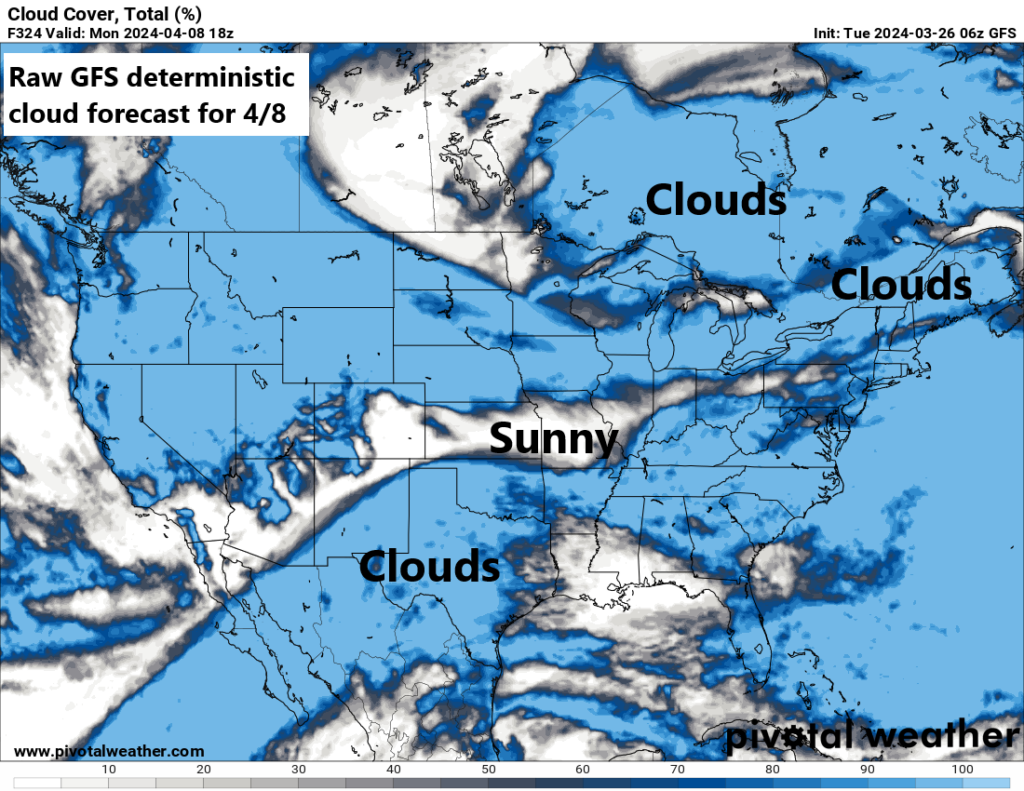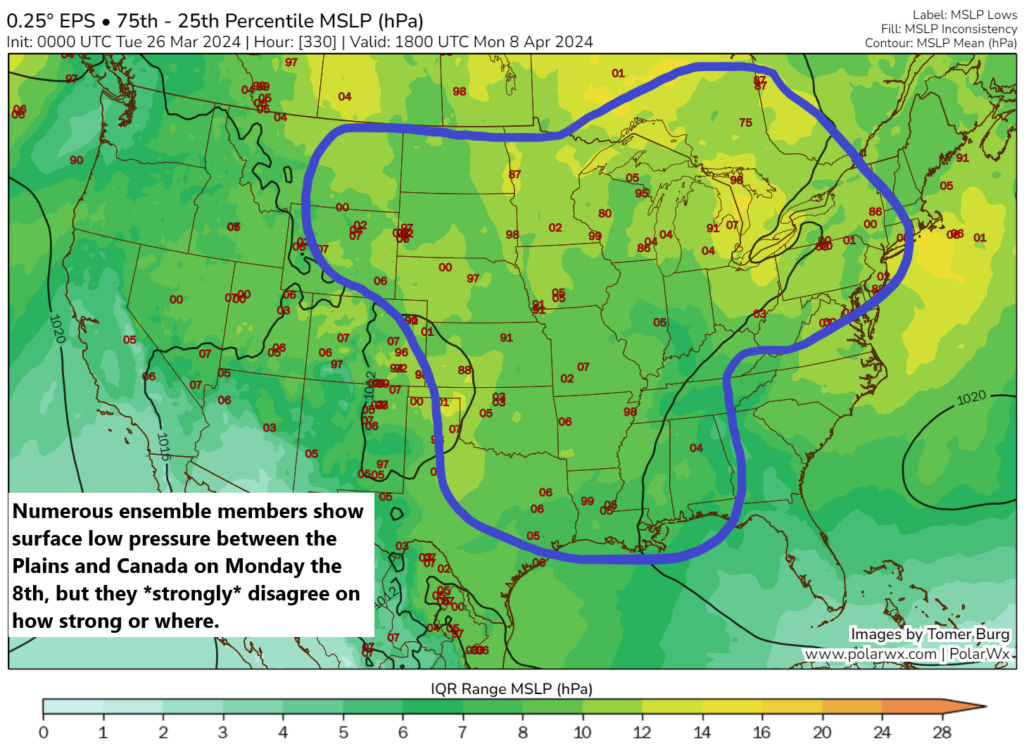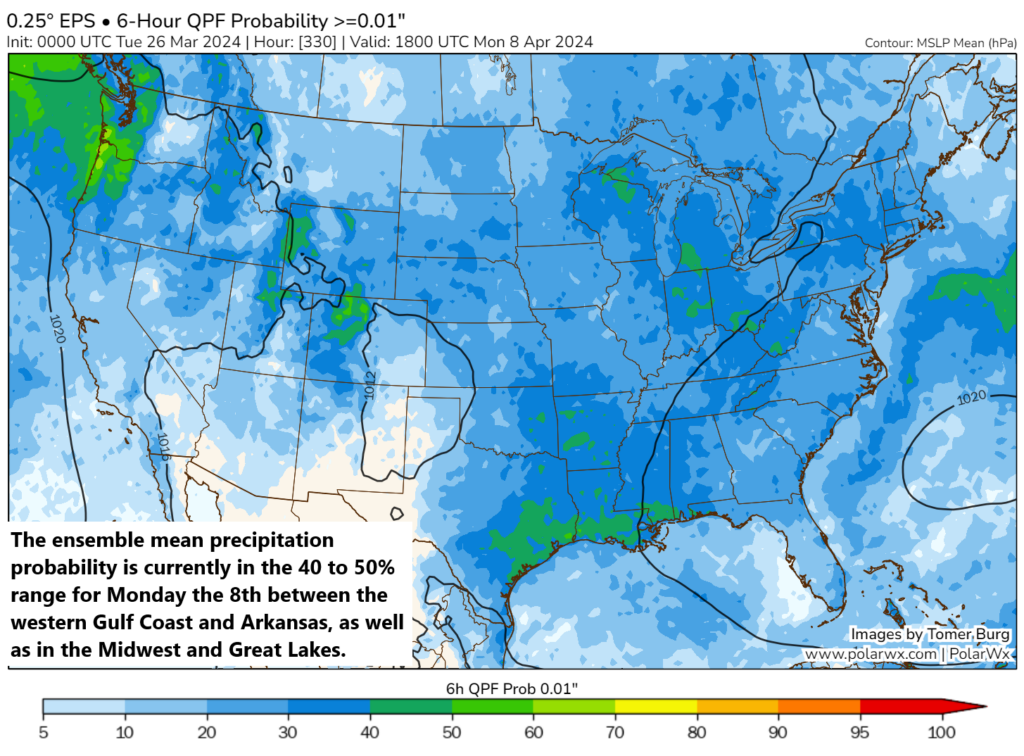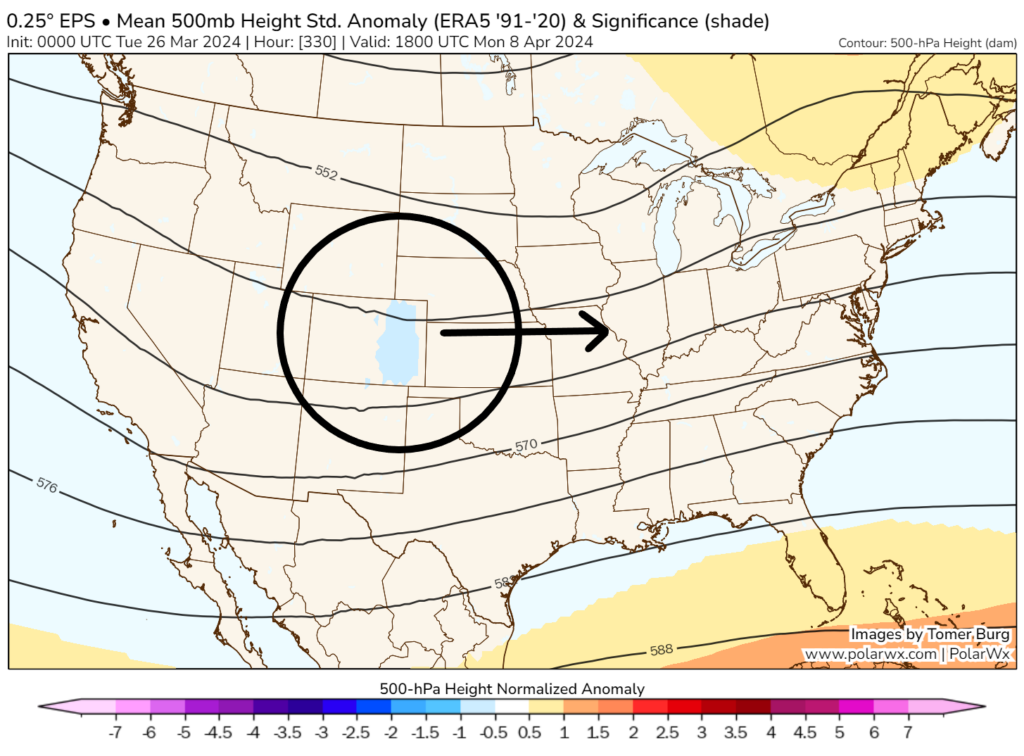Keeping it simple today: We’re going to discuss what we can say with any degree of confidence right now regarding the solar eclipse forecast for April 8th.
Spoiler alert: This looks a bit complicated.
Everyone, I mean, like everyone wants to know what the weather will be for the solar eclipse next month. So, what can we realistically look for this far in advance with respect to April 8th around midday? Well, yes, we can look at raw model data such as that offered by the GFS operational model.

That doesn’t tell us much of value, but, hey, it’s a forecast.
Sidebar: It seems a little counterintuitive, so why do we keep saying that one of the top tier weather models isn’t telling us much of value? We do this with hurricanes too. What gives? Operational models are deterministic guidance. They’re giving us one solution. Once you’re out beyond 7 to 8 days, a tool giving us one solution has limited value. Yes, it could show something relatively correctly, but most of the time it will miss on details. That’s where ensemble guidance comes in and is so useful. Why look at one run with one solution when we can look at one run and get 30 solutions or 50 solutions? Ensemble guidance allows us to do this, as it tweaks the model each time it runs. It gives a more realistic portrayal of what could happen, as well as what the risks may be. You get both a mean of 30 to 50 different outcomes, and you also can interrogate the model “under the hood” somewhat as well. And that’s what I plan to do with respect to the eclipse.
Clouds can happen in multiple ways. You can have a broad storm system that shoves a deck of cirrus and stratus clouds over you, creating a solid overcast. You can have some fair weather clouds ahead of or behind a storm system also. Those latter types are far too difficult to predict this far in advance. While those probably won’t wreck the eclipse viewing in any given spot, they could temporarily thicken up enough to cause some issues. Notably, those types of clouds also tend to form via heating of the day, so as the sun disappears behind the moon’s shadow, so may any fair weather clouds. We saw this happen in August 2017.
But what I will focus on in today’s post is the broader storm potential. Namely: How much of a chance is there that a large storm (like the one we experienced this past weekend and yesterday) will wreck solar eclipse viewing on or near the path of totality? To answer this, the first thing I want to look at is how many ensemble members have a surface low pressure system somewhere in the vicinity of the totality path.

Let’s start by looking at what the European ensemble model is showing in terms of individual low pressure centers on April 8th around midday. Underlaid on the map above from Tomer Burg is what we call the “interquartile range,” or IQR. This is the difference between the 75th minus the 25th percentile of ensemble mean sea level pressure. The greater the value, the greater the IQR, the greater the uncertainty. And indeed, you can see from that map that there is a fair bit of uncertainty, particularly from the Plains into the Great Lakes.
So initially we can say that there is a fair bit of uncertainty with regard to the potential for there to be a storm system over the Central U.S. Most of these ensemble members look weak, but the disagreement is such that we can’t say anything with any real conviction yet, other than there seems to be some potential for a system.
Let’s look at precipitation probability. In the weekend prior to the eclipse, precipitation probabilities (for any precip greater than 0.01″) are rather low right now across the center of the country. By Monday, those probabilities actually increase somewhat. In fact, the ensemble probability of at least 0.01″ of rain is greater than 50 percent over parts of Missouri, Iowa, and Illinois right now. Does that mean it’s definitely going to rain? No. Right now, we’re just gathering data.

If we look at the upper levels of the atmosphere, it appears we do have a negative 500 mb normalized height anomaly over the Rockies and into the Plains. What? If we look up about 20,000 feet in the atmosphere, it appears there is some sort of weak system trying to push out of the Rockies around the day of the eclipse.

So let’s put this all together:
- Euro ensemble model showing a good deal of uncertainty, as well as several generally weak low pressure systems in its 51 members over the Central U.S.
- A probability of precipitation in excess of 40 percent on the ensemble mean in portions of the Gulf Coast and Midwest/Lakes.
- An upper level pattern that suggests a system could be emerging out of the Rockies around that time.
None of those data points tells us anything with certainty. But the initial takeaway on this from my perspective is that there may be some parts of the path of totality that will be dealing with cloud cover on the day of the solar eclipse. Exactly where? We don’t know. We’ll check back in on this in a couple days and see what has changed.
Honestly, waste of time trying to predict clouds nearly 2 weeks out. No point in even writing this stuff up at this point. But, some people like to read into things and the suspense.
Or, we could do what people ask for and explain *why* it’s tough to forecast — and also give them insight on how we go about a forecast like this.
In which both could’ve been accomplished in a weeks time closer to the event, with the caveat that’s it’s a more accurate forecast then. When people ask, I’d say there’s no point in giving any semblance of a forecast right now for two weeks out when it’s probably going to be wrong anyway no?
RUDE.
Let’s see you do better.
True, this reminds me of the Y2K build up which was also was a nothing burger. Unless you happen to live in the path of the eclipse which isn’t most people you couldn’t care less.
People were asking like 2 months ago 😂. Like they are seers instead of meteorologists.
I think it’s fun. It’s interesting stuff I know nothing about, and explanations like the ones in this post give me little insight into a career entirely different from my own. And I will enjoy watching how this develops between now and the 8th.
Matt,
Thanks for the information about how the set-up for 4/8 might develop. Even though it is of low probability 2 weeks out, more information is better than less information. Lots of eclipse chasers would hate to see a last minute cloud forecast with no background. More info allows for alternative plans for other locations that might be more favorable for the eclipse.
Thanks,
Joe
Great stuff, Matt 😎 always so much to learn here!
🌬 ⚘⚘⚘